Deductive Reasoning Skills in Children Aged 4–8 Years Old
Abstract
:1. Introduction
2. Literature Review
2.1. Theoretical Perspectives on Deductive Reasoning
2.2. Deductive Reasoning in Early Childhood
2.3. Deductive Reasoning, Insights from Mental Model Theory
2.4. Findings about Deductive Reasoning Skills
2.5. Context of the Study
2.6. Rationale of the Study
2.7. Research Questions
- RQ1:
- Do children’s deductive reasoning skills exhibit significant differences with respect to their country, gender, and age groups?
- RQ2:
- What are the significant differences between the two countries by gender and age?
- RQ3:
- What is the relationship between children’s background characteristics and their deductive reasoning skills development?
- RQ4:
- What are the factors that can predict the development of children’s deductive reasoning skills, considering their background characteristics?
3. Methods
3.1. Participants
3.2. Instrument and Procedure
3.3. Analysis
3.4. Reliability and Validity of the Instrument
3.5. Confirmatory Factor Analysis and Baseline Models of the Instrument
3.6. Measurement Invariance of the Deductive Reasoning Test
3.7. Latent Mean Differences across Groups
4. Results
4.1. Addressing RQ1: Investigating the Differences in Children’s Deductive Reasoning Skills across Countries, Genders, and Age Groups
4.1.1. Differences between the Two Countries
4.1.2. Differences between Genders
4.1.3. Differences across Age Groups
4.2. Addressing RQ2: Comparison of Two Countries by Gender and Age Groups
4.3. Addressing RQ3: Relationship between Children’s Background Variables and Deductive Reasoning Skills
4.4. Addressing RQ4: Predicting Effects of Background Variables on Deductive Reasoning Skills
4.5. Predicting Effects of Background Variables for Each Country
5. Discussion
6. Conclusions
Author Contributions
Funding
Institutional Review Board Statement
Informed Consent Statement
Data Availability Statement
Conflicts of Interest
References
- Almamari, Khalid, and Anne Traynor. 2021. The role of general and specific cognitive abilities in predicting performance of three occupations: Evidence from bifactor models. Journal of Intelligence 9: 40. [Google Scholar] [CrossRef]
- Astorga, Miguel López. 2016. Fourteen modal theorems consistent with the theory of mental models. Prometeica Revista de Filosofia y Ciencias 1: 1–23. [Google Scholar]
- Astorga, Miguel López. 2017. There can be a syntax of thought related to logical forms. Mediterranean Journal of Social Sciences 8: 270–78. [Google Scholar] [CrossRef]
- Astorga, Miguel López. 2019. ‘But’ and its role in the building of mental representations. Praxis Filosófica 50: 11–20. [Google Scholar] [CrossRef]
- Barrouillet, Pierre, and Jean-François Lecas. 1998. How can mental models theory account for content effects in conditional reasoning? A developmental perspective. Cognition 67: 209–53. [Google Scholar] [CrossRef]
- Borbélyová, Diana, Tatiana Slezáková, Anna Tirpáková, and Zuzana Kurucová. 2019. Using an adaptation programme to introduce children to the early years of schooling in Slovakia. Education 47: 730–45. [Google Scholar] [CrossRef]
- Brečka, Peter, Monika Valentová, and Drahoslav Lančarič. 2022. The implementation of critical thinking development strategies into technology education: The evidence from Slovakia. Teaching and Teacher Education 109: 103555. [Google Scholar] [CrossRef]
- Carreira, Susana, Nélia Amado, and Hélia Jacinto. 2020. Venues for analytical reasoning problems: How children produce deductive reasoning. Education Sciences 10: 169. [Google Scholar] [CrossRef]
- Carroll, John B. 1993. Human Cognitive Abilities: A Survey Offactor-Analytic Studies. Cambridge: Cambridge University Press. [Google Scholar] [CrossRef]
- Chiu, Yen-Lin, Chin-Chung Tsai, and Jyh-Chong Liang. 2015. Testing measurement invariance and latent mean differences across gender groups in college students’ internet-specific epistemic beliefs. Australasian Journal of Educational Technology 31: 486–99. [Google Scholar] [CrossRef]
- Chua, Yan Piaw. 2023. A Step-by-Step Guide PLS-SEM Data Analysis Using SmartPLS4 (pp. 1–311). Researchtree Education. Available online: https://www.researchgate.net/publication/362790516_A_step-by-step_guide_PLS-SEM_data_analysis_using_SmartPLS_4 (accessed on 2 October 2023).
- Coetzee, John P., Micah A. Johnson, Youngzie Lee, Allan D. Wu, Marco Iacoboni, and Martin M. Monti. 2023. Dissociating language and thought in human reasoning. Brain Sciences 13: 67. [Google Scholar] [CrossRef]
- Cohen, Jacob. 1988. Statistical Power Analysis for the Behavioral Sciences, 2nd ed. Hillsdale: Lawrence Erlbaum Associates. [Google Scholar]
- Cortes, Robert A., Adam B. Weinberger, and Adam E. Green. 2023. The mental models training app: Enhancing verbal reasoning through a cognitive training mobile application. Frontiers in Psychology 14: 1150210. [Google Scholar] [CrossRef]
- Csapó, Benő, Gyöngyvér Molnár, and József Nagy. 2014. Computer-based assessment of school readiness and early reasoning. Journal of Educational Psychology 106: 639–50. [Google Scholar] [CrossRef]
- de Chantal, Pier-Lucde, and Henry Markovits. 2017. The capacity to generate alternative ideas is more important than inhibition for logical reasoning in preschool-age children. Memory and Cognition 45: 208–20. [Google Scholar] [CrossRef] [PubMed]
- de Chantal, Pier-Lucde, Émilie Gagnon-St-Pierre, and Henry Markovits. 2020. Divergent thinking promotes deductive reasoning in preschoolers. Child Development 91: 1081–97. [Google Scholar] [CrossRef] [PubMed]
- Demetriou, Andreas, Antigoni Mouyi, and George Spanoudis. 2008. Modelling the structure and development of g. Intelligence 36: 437–54. [Google Scholar] [CrossRef]
- Demetriou, Andreas, George Spanoudis, Christou Christou, Samuel Greiff, Nikolaos Makris, Mari-Paulilina Vainikainen, Hudson Golino, and Eleftheria Gonida. 2023. Cognitive and personality predictors of school performance from preschool to secondary school: An overarching model. Psychological Review 130: 480–512. [Google Scholar] [CrossRef] [PubMed]
- Demir-Lira, Ö-Ece, Jérôme Prado, and James R. Booth. 2021. Neurocognitive basis of deductive reasoning in children varies with parental education. Human Brain Mapping 42: 3396–410. [Google Scholar] [CrossRef] [PubMed]
- Escolano-Pérez, Elena, and Marta Bestué. 2021. Academic achievement in Spanish secondary school students: The inter-related role of executive functions, physical activity and gender. International Journal of Environmental Research and Public Health 18: 1816. [Google Scholar] [CrossRef]
- Evans, Jonathan. St. B. T. 1993. The mental model theory of conditional reasoning: Critical appraisal and revision. Cognition 48: 1–20. [Google Scholar] [CrossRef]
- Evans, Jonathan. St. B. T. 2005. Deductive Reasoning. In The Cambridge Handbook of Thinking and Reasoning. Edited by Keith J. Holyoak and Robert G. Morrison. Cambridge: Cambridge University Press, pp. 169–84. Available online: http://books.google.com/books?hl=fr&lr=&id=znbkHaC8QeMC&pgis=1 (accessed on 3 January 2023).
- Feiman, Roman, Shilpa Mody, and Susan Carey. 2022. The development of reasoning by exclusion in infancy. Cognitive Psychology 135: 101473. [Google Scholar] [CrossRef]
- Franks, Bridget A. 1997. Deductive reasoning with prose passages: Effects of age, inference form, prior knowledge, and reading skill. International Journal of Behavioral Development 21: 501–35. [Google Scholar] [CrossRef]
- Gagné, Françoys. 1993. Constructs and models pertaining to exceptional human abilities. In International Handbook of Research and Development of Giftedness and Talent. Edited by Kurta A. Heller, Franz J. Mönks and A. Harry Passow. Oxford: Pergamon Press, pp. 63–85. [Google Scholar]
- García-Madruga, Juan Antonio, Isabel Orenes, José Óscar Vila Chaves, and Isabel Gómez-Veiga. 2022. Executive functions and improvement of thinking: An intervention program to enhance deductive reasoning abilities. Spanish Journal of Psychology 25: e32. [Google Scholar] [CrossRef]
- Gauffroy, Caroline, and Pierre Barrouillet. 2009. Heuristic and analytic processes in mental models for conditionals: An integrative developmental theory. Developmental Review 29: 249–82. [Google Scholar] [CrossRef]
- Gazzo Castañeda, Lupita Estefania, Benjamin Sklarek, Dennis E. Dal Mas, and Markus Knauff. 2023. Probabilistic and deductive reasoning in the human brain. NeuroImage 275: 120180. [Google Scholar] [CrossRef] [PubMed]
- Gomes, Cristiano Mauro Assis, Hudson F. Golino, and Igor Gomes Menezes. 2014. Predicting school achievement rather than intelligence: Does metacognition matter? Psychology 5: 1095–110. [Google Scholar] [CrossRef]
- Goñi, Eider, Miren Zubeldia, Maravillas Díaz-Gómez, and Oihane Fernández-Lasarte. 2020. Can we measure musically active people’s music skills and achievement self-concept? Structure and invariance of CAMU, a Spanish questionnaire. Music Education Research 22: 478–90. [Google Scholar] [CrossRef]
- Hancock, Gregory R. 2001. Effect size, power, and sample size determination for structured means modeling and mimic approaches to between-groups hypothesis testing of means on a single latent construct. Psychometrika 66: 373–88. [Google Scholar] [CrossRef]
- Hattori, Masasi. 2016. Probabilistic representation in syllogistic reasoning: A theory to integrate mental models and heuristics. Cognition 157: 296–320. [Google Scholar] [CrossRef]
- Heled, Eyal, Noa Elul, Maurice Ptito, and Daniel Robert Chebat. 2022. Deductive reasoning and working memory skills in individuals with blindness. Sensors 22: 2062. [Google Scholar] [CrossRef]
- Jensen, Arthur R. 1998. The g Factor: The Science of Mental Ability. Westport: Praeger. [Google Scholar]
- Johnson-Laird, P. N., and Ruth M. J. Byrne. 1995. A model point of view. Thinking and Reasoning 1: 339–50. [Google Scholar] [CrossRef]
- Johnstone, Avril, Anne Martin, Rita Cordovil, Ingunn Fjortoft, Susanna Iivonen, Boris Jidovtseff, Frederico Lopes, John J. Reilly, Hilary Thomson, Valerie Wells, and et al. 2022. Nature-Based Early Childhood Education and Children’s Social, Emotional and Cognitive Development: A mixed-methods systematic review. International Journal of Environmental Research and Public Health 19: 5967. [Google Scholar] [CrossRef]
- Józsa, Krisztián, Balázs Török, and Cerissa Stevenson. 2018. Preschool and kindergarten in Hungary and the United States: A comparison within transnational development policy. International Journal of Educational Development 62: 88–95. [Google Scholar] [CrossRef]
- Józsa, Krisztián, Tun Zaw Oo, Diana Borbélyová, and Gabriella Zentai. 2023a. Exploring the accuracy and consistency of a school readiness assessment tool for preschoolers: Reliability, validity and measurement invariance analysis. Journal of Intelligence 11: 189. [Google Scholar] [CrossRef] [PubMed]
- Józsa, Krisztián, Tun Zaw Oo, Diana Borbélyová, and Gabriella Zentai. 2023b. Exploring the growth and predictors of fine motor skills in young children aged 4–8 years. Education Sciences 13: 939. [Google Scholar] [CrossRef]
- Kaufman, Scott Barry, Colin G. DeYoung, Deidre L. Reis, and Jeremy R. Gray. 2011. General intelligence predicts reasoning ability even for evolutionarily familiar content. Intelligence 39: 311–22. [Google Scholar] [CrossRef]
- Kim, Sun-Hee, Eunkyung Lee, and Jin-Hwa Park. 2022. Measurement invariance and latent mean differences in the Nurses’ Emotional Labour Scale. Journal of Nursing Research 30: e239. [Google Scholar] [CrossRef] [PubMed]
- Kline, Rex B. 2015. Principles and Practice of Structural Equation Modeling, 4th ed. London: Guilford Press. [Google Scholar]
- Kurincová, Viera, Tatiana Slezáková, and Anna Klimentová. 2017. Family and school: Preparing parents for parenthood of school-age-child. In Rodzina Niejedno ma Oblicze-refleksja o Wspolczesnej Rodzine. Katowice: Wydawnictwo Uniwersytetu Slaskiego, pp. 131–43. [Google Scholar]
- Langer-Buchwald, J. 2020. The situation of migrant children in the Hungarian and the Austrian education system: Multilingualism, interculturalism, and integration. Hungarian Educational Research Journal 9: 434–61. [Google Scholar] [CrossRef]
- Lepes, Josip, Szabolcs Halasi, and Josip Ivanovic. 2016. Motor abilities and school readiness of disadvantaged children. Croatian Journal of Education-Hrvatski Casopis Za Odgoj I Obrazovanje 18: 87–101. [Google Scholar]
- Majerčíková, Jana, and Sona Lorencová. 2021. The attitudes of parents towards the introduction of compulsory pre-school education in Slovakia. Acta Educationis Generalis 11: 105–24. [Google Scholar] [CrossRef]
- Markovits, Henry, Michael Schleifer, and Lorraine Fortier. 1989. Development of elementary deductive reasoning in young children. Developmental Psychology 25: 787–93. [Google Scholar] [CrossRef]
- Mashar, Riana, and Febru Pudji Astuti. 2022. Correlation between parenting skills, children’s emotional and intelligence quotient with school readiness. JPUD Jurnal Pendidikan Usia Dini 16: 215–23. [Google Scholar] [CrossRef]
- Mitchell, Robert W. 1993. Mental models of mirror-self-recognition: Theories two. New Ideas in Psychology 11: 295–325. [Google Scholar] [CrossRef]
- Mohammad, Haya, and H. Albaqawi. 2023. Inductive and deductive reasoning in mathematics of female middle school students. Journal of Positive School Psychology 7: 758–66. Available online: http://journalppw.com (accessed on 7 November 2023).
- Nagy, József. 1976. PREFER, Preventív Fejlettségvizsgáló Rendszer 5–6 éves gyermekek iskolakészültségének mérésére [Preventive Development Assessment System for Children Aged 5–6 Years]. Budapest: MTA Pedagógiai Kutatócsoport. [Google Scholar]
- Nagy, József, Tibor Vidákovich Krisztián Józsa, and Margit Fazekasné Fenyvesi. 2004. DIFER programcsomag: Diagnosztikus fejlődésvizsgáló és kritériumorientált fejlesztő rendszer 4–8 évesek számára [DIFER: A Diagnostic System of Assessment and Criterion-Referenced Improvement between the Ages of 4–8]. Szeged: Mozaik Kiadó. [Google Scholar]
- Nagy, Ádám, Laszlo Trencsenyi, and Kinga Horvathova. 2018. The Hungarian education system and its school-critical responses. Journal of Educational Sciences 37: 18–26. [Google Scholar] [CrossRef]
- Neumann, Denise, Elizabeth R. Peterson, Lisa Underwood, Susan M. B. Morton, and Karen E. Waldie. 2021. The development of cognitive functioning indices in early childhood. Cognitive Development 60: 101098. [Google Scholar] [CrossRef]
- Newton, Elizabeth J., Maxwel J. Roberts, and Chris Donlan. 2010. Deductive reasoning in children with specific language impairment. British Journal of Developmental Psychology 28: 71–87. [Google Scholar] [CrossRef] [PubMed]
- Panizzon, Matthew S., Eero Vuoksimaa, Kelly M. Spoon, Kristen C. Jacobson, Michael J. Lyons, Carol E. Franz, Hong Xian, Terrie Vasilopoulos, and William S. Kremen. 2014. Genetic and environmental influences on general cognitive ability: Is g a valid latent construct? Intelligence 43: 65–76. [Google Scholar] [CrossRef] [PubMed]
- Pathan, Habibullah, Rafique A. Memon, Shumaila Memon, Ali Raza Khoso, and Illahi Bux. 2018. A critical review of Vygotsky’s socio-cultural theory in second language acquisition. International Journal of English Linguistics 8: 232. [Google Scholar] [CrossRef]
- Podráczky, Judit, Katalin Hajduné Holló, Diana Borbélyová, Alexendra Nagyová, and Krisztián Józsa. 2022. A magyarországi és szlovákiai óvodai nevelési program összehasonlító elemzése [A comparative analysis of the Hungarian and Slovak preschool curricula]. Danubius Noster 10: 107–32. [Google Scholar] [CrossRef]
- Pupala, Branislav, Hani Yulindrasari, and Maria Melita Rahardjo. 2022. Diverstity and centrism in two contrasting early childhood education and care systems: Slovakia and Indonesia compared. Human Affairs 32: 145–61. [Google Scholar] [CrossRef]
- Schunk, Dale H., and Maria K. DiBenedetto. 2020. Motivation and social cognitive theory. Contemporary Educational Psychology 60: 101832. [Google Scholar] [CrossRef]
- Simatwa, Enose M. W. 2010. Piaget’s theory of intellectual development and its implication for instructional management at presecondary school level. Educational Research and Reviews 5: 366–71. [Google Scholar]
- Solari, Emily. 2014. Longitudinal prediction of 1st and 2nd grade English oral reading fluency in ELL. Journal of Adolescence 74: 274–83. [Google Scholar] [CrossRef]
- Spearman, Charles. 1927. The Abilities of Man, Their Nature and Measurement. New York: Macmillan. [Google Scholar]
- Zentai, Gabriella, Diana Borbélyová, Krisztián Józsa, Orsovics Yvette, Kinga Horváth, Nagyová Alexandra, and Bencéné Fekete Andrea. 2023. A szlovákiai és a magyar általános iskolai tantervek összehasonlító vizsgálata a DIFER-készségek fejlesztése szempontjából [A comparative study of the Slovak and Hungarian primary school curricula from the point of view of the development of DIFER skills]. Eruditio-Educatio 18: 78–94. [Google Scholar] [CrossRef]
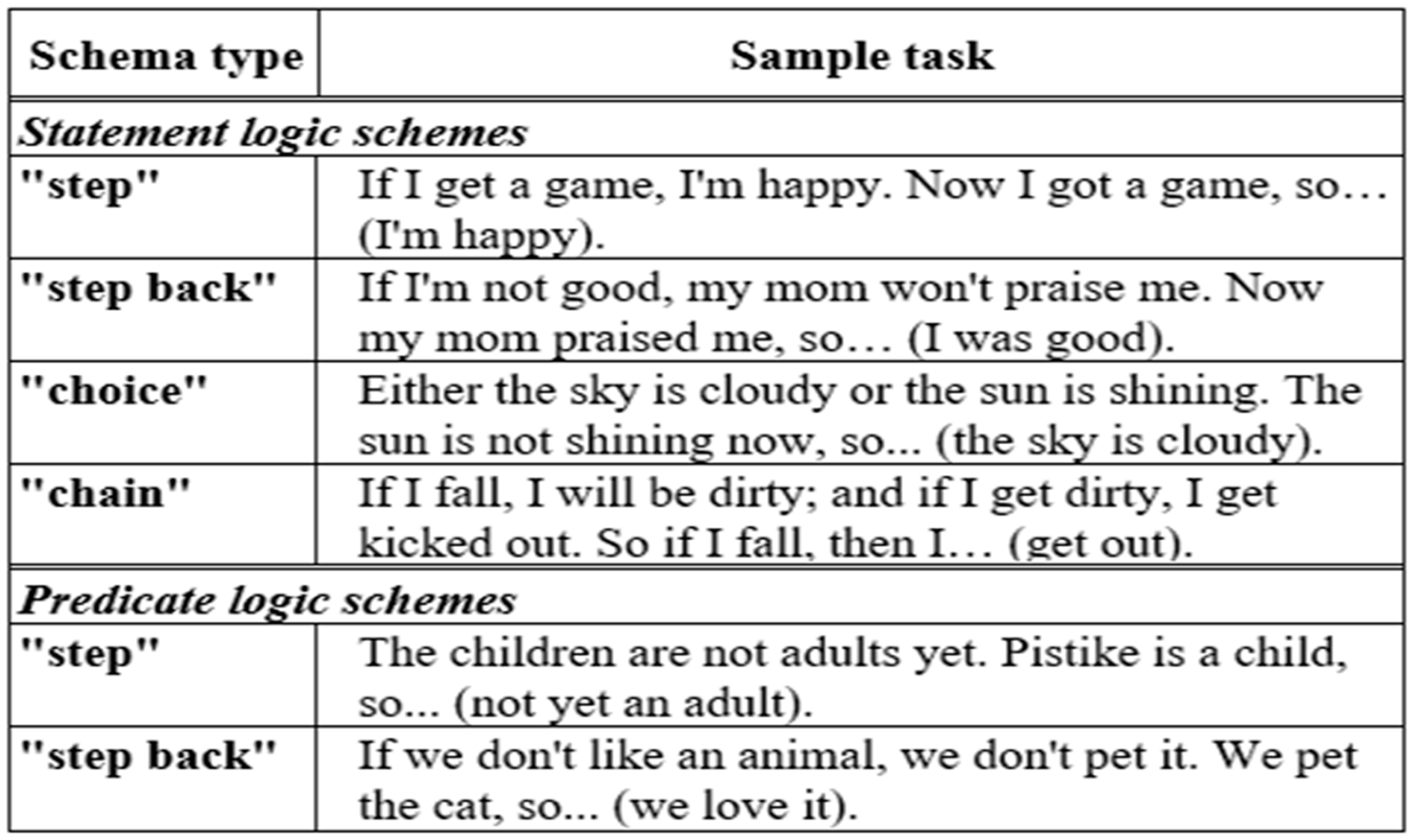




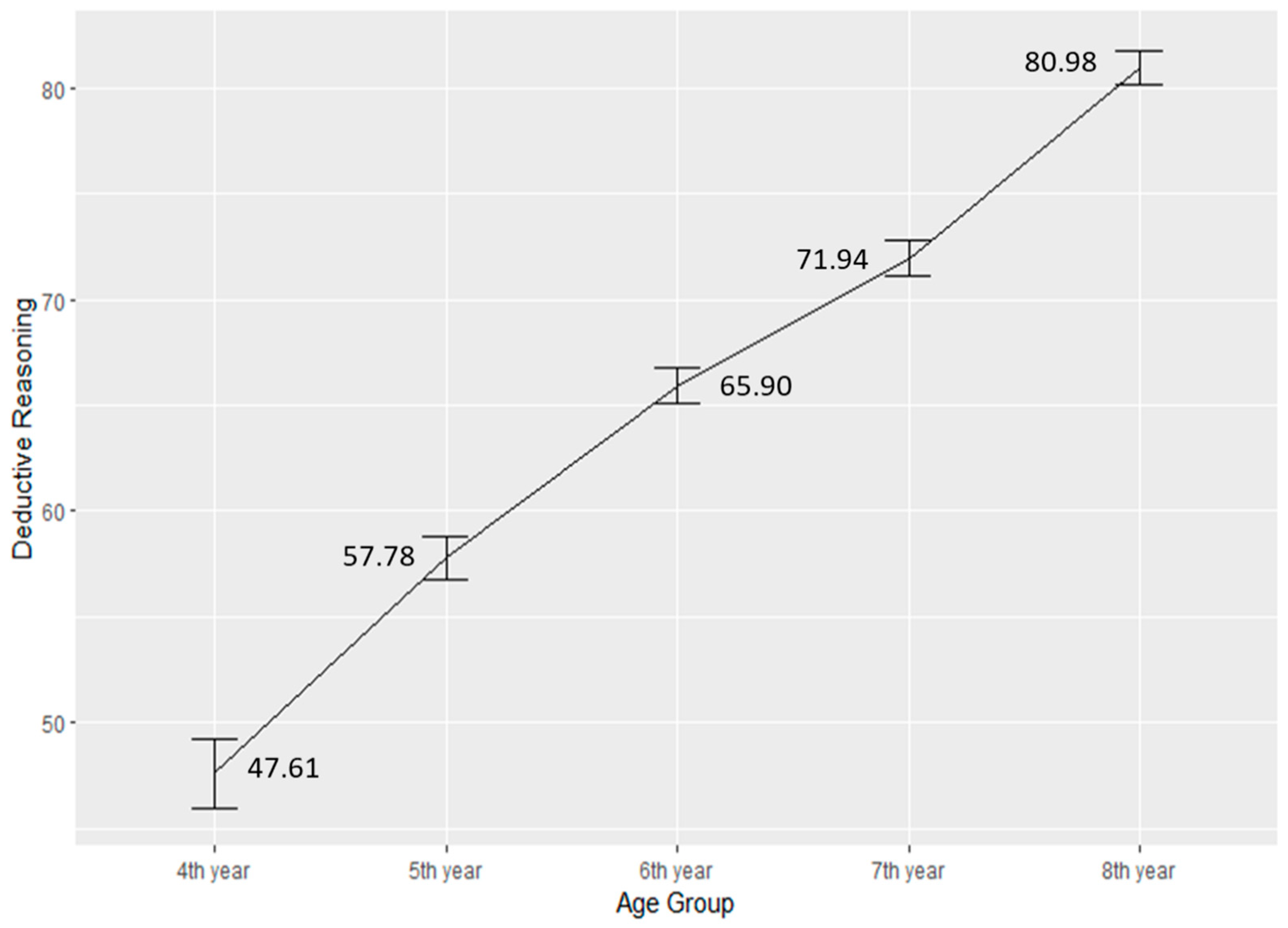
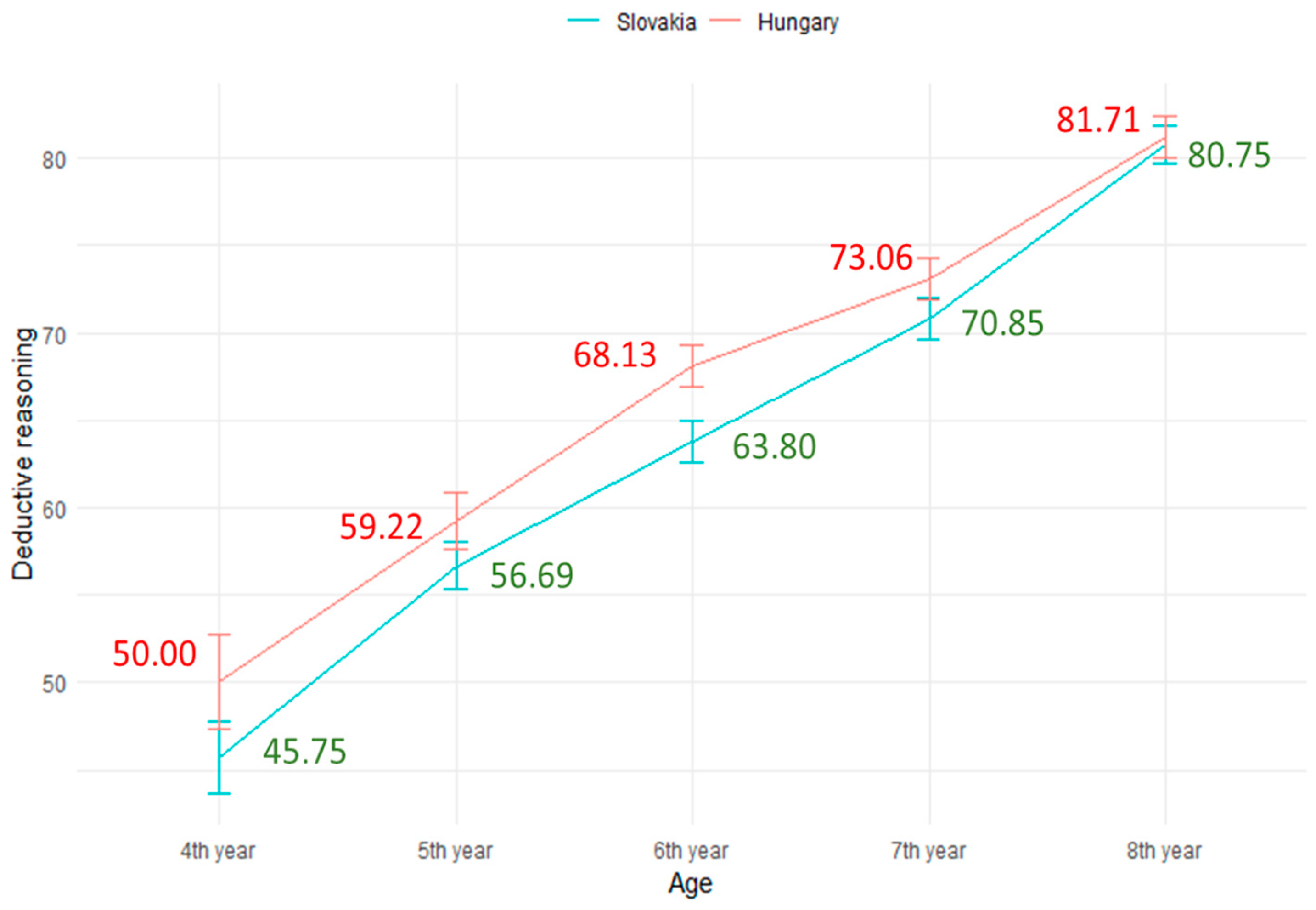
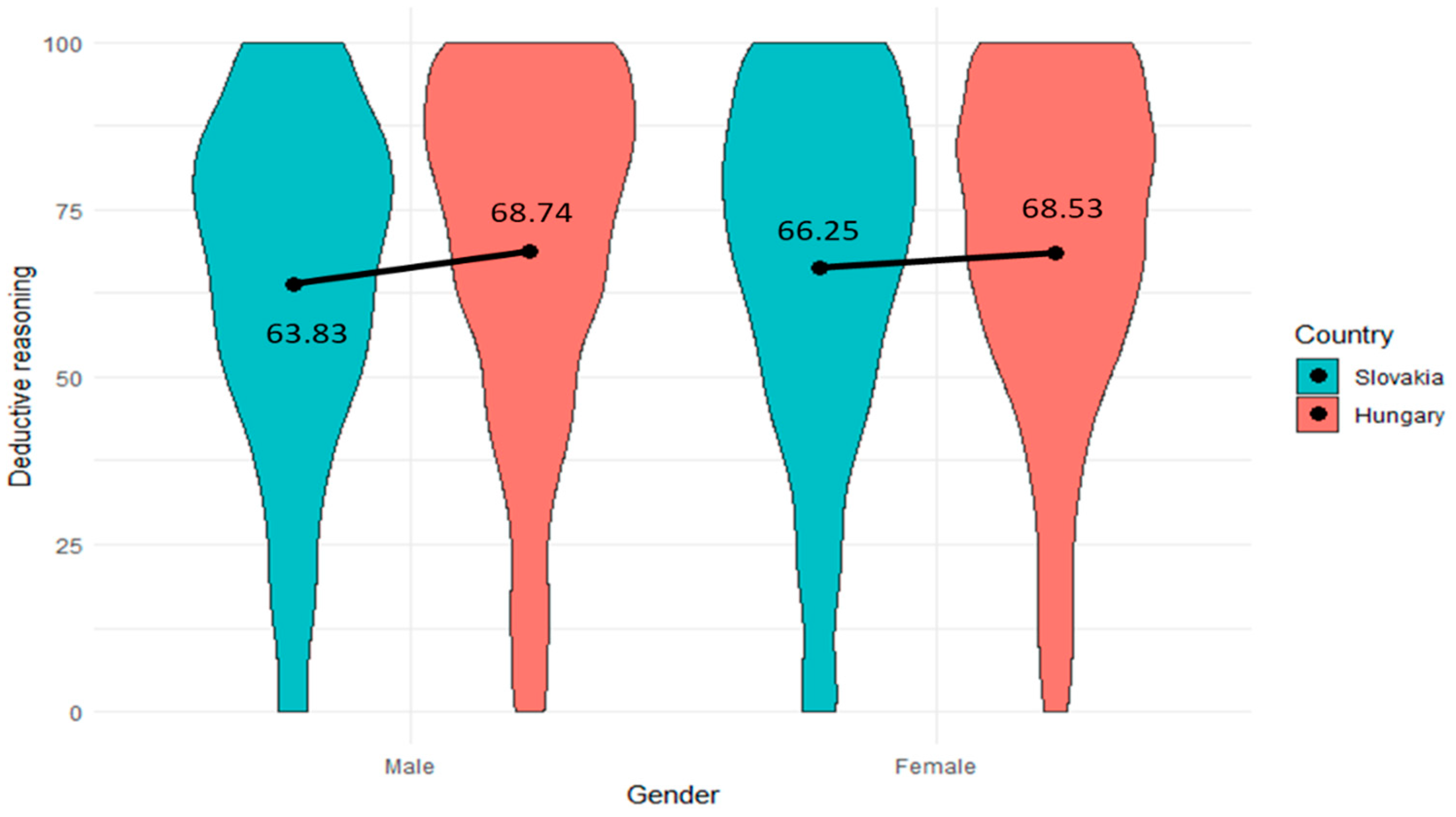
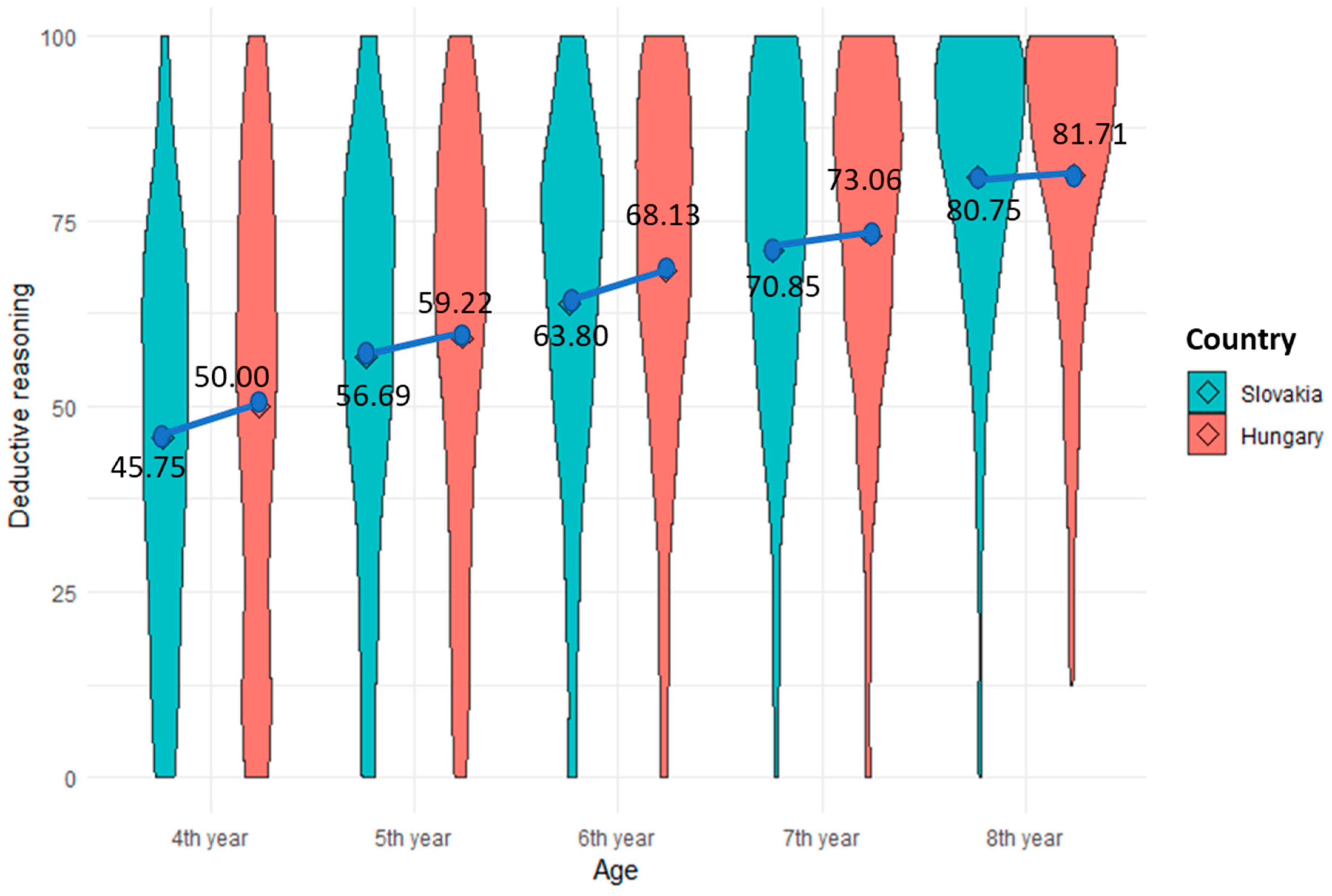
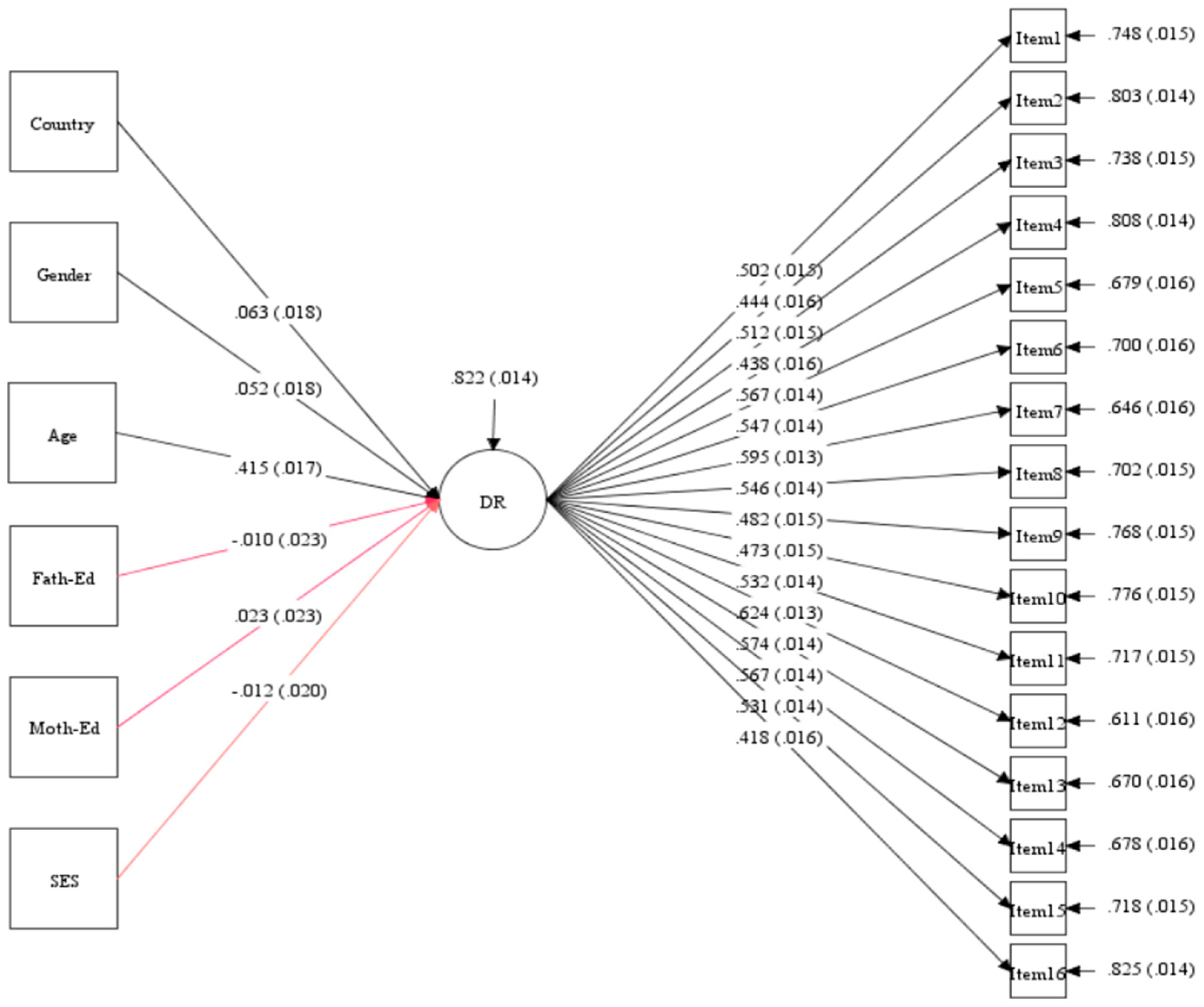

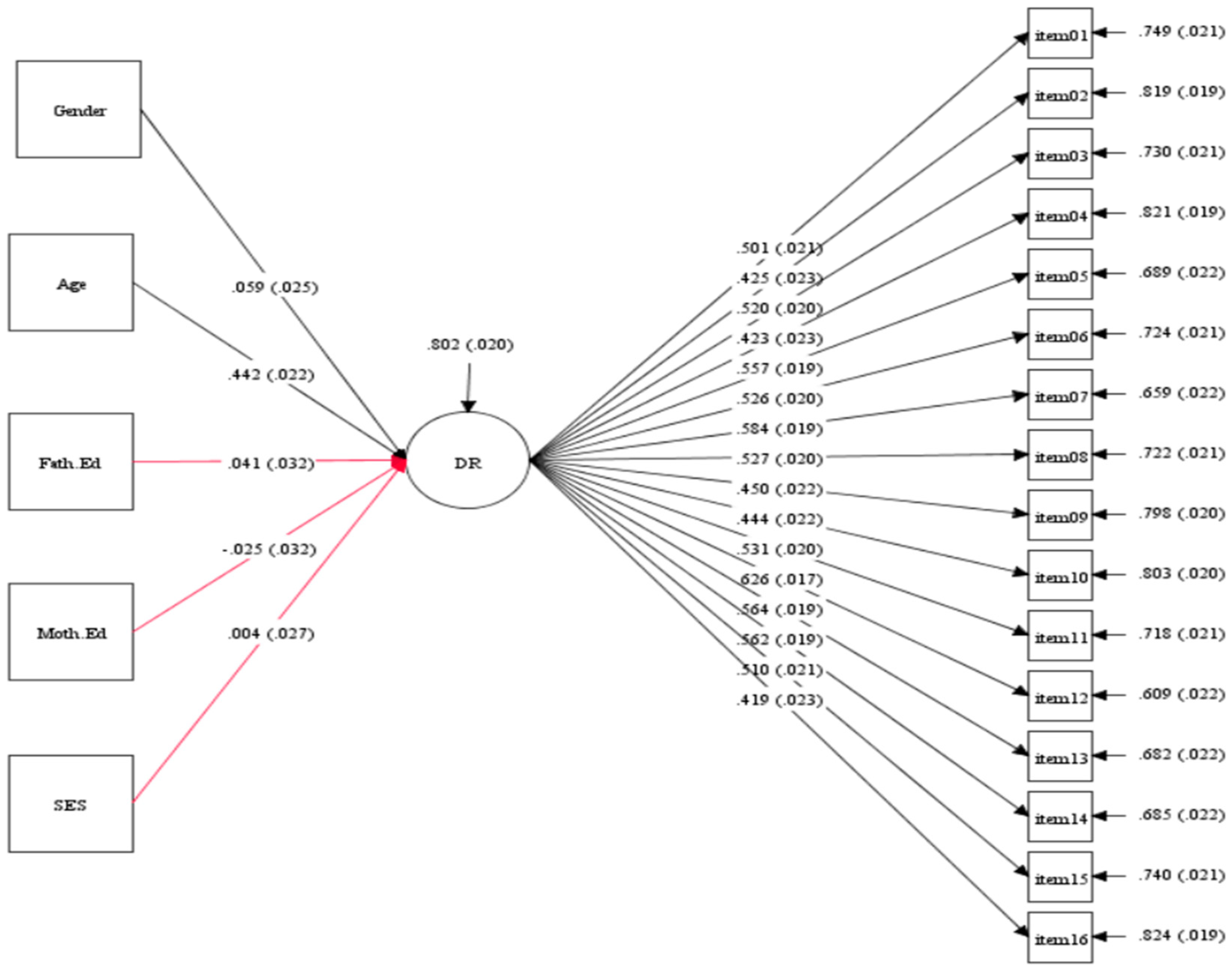
| Variables | Number | Percent |
|---|---|---|
| Country | (Total—3050) | - |
| Slovakia | 1609 | 52.80% |
| Hungary | 1441 | 47.25% |
| Gender | (2 groups) | - |
| Male | 1641 | 53.82% |
| Female | 1409 | 46.18% |
| Age | (5 groups) | - |
| 4th year | 282 | 9.24% |
| 5th year | 652 | 21.37% |
| 6th year | 832 | 27.27% |
| 7th year | 690 | 22.62% |
| 8th year | 594 | 19.48% |
| Mother’s education | (3 groups) | - |
| Primary | 522 | 17.08% |
| Secondary | 1692 | 55.47% |
| Tertiary | 836 | 27.41% |
| Father’s education | (3 groups) | - |
| Primary | 497 | 16.3% |
| Secondary | 1948 | 63.9% |
| Tertiary | 605 | 19.8% |
| Socio-economic status | (3 groups) | - |
| Low | 458 | 15.02% |
| Average | 2307 | 75.44% |
| High | 285 | 9.34% |
| Models | Chi Square/df | p | CFI (≥0.90) * | TLI (≥0.90) * | RMSEA [90% CI] (≤0.07) * | SRMR (≤0.07) * |
|---|---|---|---|---|---|---|
| Hungary | 341.31/104 | <0.001 | 0.954 | 0.947 | 0.040 [0.035, 0.045] | 0.030 |
| Slovakia | 402.78/104 | <0.001 | 0.942 | 0.933 | 0.042 [0.038, 0.047] | 0.032 |
| Male | 300.66/104 | <0.001 | 0.964 | 0.959 | 0.034 [0.030, 0.038] | 0.027 |
| Female | 442.84/104 | <0.001 | 0.931 | 0.920 | 0.048 [0.044, 0.053] | 0.036 |
| 4th year | 202.02/104 | <0.001 | 0.905 | 0.901 | 0.058 [0.046, 0.070] | 0.051 |
| 5th year | 256.59/104 | <0.001 | 0.926 | 0.915 | 0.047 [0.040, 0.055] | 0.041 |
| 6th year | 224.69/104 | <0.001 | 0.948 | 0.940 | 0.037 [0.031, 0.044] | 0.034 |
| 7th year | 204.30/104 | <0.001 | 0.939 | 0.930 | 0.037 [0.030, 0.045] | 0.037 |
| 8th year | 229.00/104 | <0.001 | 0.915 | 0.901 | 0.045 [0.037, 0.053] | 0.041 |
| Models | Chi Square/df | CFI | RMSEA | SRMR | ∆CFI (<0.01) * | ∆RMSEA (<0.015) * | ∆SRMR (<0.03) * | Decision |
|---|---|---|---|---|---|---|---|---|
| Country (Hungary, Slovakia) | ||||||||
| Configural | 744.10/208 | 0.948 | 0.029 | 0.032 | - | - | - | Accept |
| Metric | 753.70/223 | 0.949 | 0.028 | 0.033 | 0.001 | −0.001 | 0.001 | Accept |
| Scalar | 774.50/238 | 0.948 | 0.027 | 0.033 | −0.001 | −0.001 | 0.000 | Accept |
| Residual | 864.80/254 | 0.941 | 0.028 | 0.035 | −0.007 | 0.001 | 0.002 | Accept |
| Gender (Male, Female) | ||||||||
| Configural | 743.50/208 | 0.948 | 0.029 | 0.027 | - | - | - | Accept |
| Metric | 752.40/223 | 0.949 | 0.028 | 0.027 | 0.001 | −0.001 | 0.000 | Accept |
| Scalar | 762.20/238 | 0.949 | 0.027 | 0.027 | 0.000 | −0.001 | 0.000 | Accept |
| Residual | 773.70/254 | 0.950 | 0.026 | 0.028 | 0.001 | −0.001 | 0.001 | Accept |
| Age (4th year, 5th year, 6th year, 7th year, 8th year) | ||||||||
| Configural | 1116.80/520 | 0.930 | 0.019 | 0.051 | - | - | - | Accept |
| Metric | 1227.60/580 | 0.924 | 0.019 | 0.057 | −0.006 | 0.000 | 0.006 | Accept |
| Scalar | 1365.60/640 | 0.915 | 0.020 | 0.058 | −0.009 | 0.001 | 0.001 | Accept |
| Residual | 2366.80/704 | 0.805 | 0.028 | 0.072 | −0.110 | 0.008 | 0.014 | Reject |
| Groups | Mean Difference (MD) | Standard Error (SE) | Critical Ratios (CR) | Effect Size (d) |
|---|---|---|---|---|
| Slovakia (Reference) vs. Hungary | 0.03 | 0.005 | 12.583 | 0.141 |
| Boys (Reference) vs. girls | 0.01 | 0.004 | 12.821 | 0.046 |
| 4th year (Reference) vs. 5th year | 0.09 | 0.006 | 10.743 * | 0.350 |
| 4th year (Reference) vs. 6th year | 0.16 | 0.004 | 11.286 *** | 0.821 |
| 4th year (Reference) vs. 7th year | 0.22 | 0.003 | 10.671 *** | 0.899 |
| 4th year (Reference) vs. 8th year | 0.29 | 0.002 | 10.002 *** | 0.978 |
| 5th year (Reference) vs. 6th year | 0.10 | 0.004 | 11.270 *** | 0.418 |
| 5th year (Reference) vs. 7th year | 0.15 | 0.003 | 10.659 *** | 0.851 |
| 5th year (Reference) vs. 8th year | 0.23 | 0.002 | 9.992 *** | 0.936 |
| 6th year (Reference) vs. 7th year | 0.10 | 0.003 | 10.640 *** | 0.389 |
| 6th year (Reference) vs. 8th year | 0.18 | 0.002 | 9.977 *** | 0.912 |
| 7th year (Reference) vs. 8th year | 0.14 | 0.002 | 9.962 *** | 0.800 |
| 4th Year | 2 | 3 | 4 | 5 | 6 |
|---|---|---|---|---|---|
| 1. Country 2. Gender 3. Mother’s ed. 4. Father’s ed. 5. SES 6. Deductive reasoning | 0.020 | 0.072 0.090 | 0.009 0.073 0.588 ** | 0.005 −0.007 0.437 ** 0.317 ** | 0.076 −0.075 0.026 0.066 0.070 |
| 5th year | 2 | 3 | 4 | 5 | 6 |
| 1. Country 2. Gender 3. Mother’s ed. 4. Father’s ed. 5. SES 6. Deductive reasoning | −0.124 ** | −0.016 0.024 | −0.004 0.061 0.668 ** | 0.031 0.088 0.430 ** 0.419 * | 0.048 0.055 0.014 0.023 0.009 |
| 6th year | 2 | 3 | 4 | 5 | 6 |
| 1. Country 2. Gender 3. Mother’s ed. 4. Father’s ed. 5. SES 6. Deductive reasoning | −0.069 * | −0.010 0.058 | −0.002 −0.010 0.563 ** | −0.002 −0.028 0.297 ** 0.243 ** | 0.088 * 0.063 0.031 0.041 −0.015 |
| 7th year | 2 | 3 | 4 | 5 | 6 |
| 1. Country 2. Gender 3. Mother’s ed. 4. Father’s ed. 5. SES 6. Deductive reasoning | −0.126 ** | −0.025 0.035 | 0.002 0.065 0.634 ** | 0.045 0.040 0.488 ** 0.499 ** | 0.050 0.084 0.161 ** 0.131 ** −0.004 |
| 8th year | 2 | 3 | 4 | 5 | 6 |
| 1. Country 2. Gender 3. Mother’s ed. 4. Father’s ed. 5. SES 6. Deductive reasoning | −0.206 ** | −0.012 0.016 | 0.008 −0.015 0.642 ** | 0.081 * −0.029 0.329 ** 0.337 ** | 0.012 0.034 0.128 ** 0.105 ** −0.070 |
| Model | Dummy Variables | Unstandardized Coefficients | Standardized Coefficients | t | Sig | Correlations | Collinearity Statistics | ||||
|---|---|---|---|---|---|---|---|---|---|---|---|
| Β | Std. Error | β | Zero-Order | Partial | Part | Tolerance | VIF | ||||
| Country (Slovakia/reference) | Hungary | 3.58 | 0.934 | 0.069 | 3.843 | <0.001 | 0.069 | 0.069 | 0.069 | 1.000 | 1.000 |
| Gender (Boy/reference) | Girl | 0.794 | 0.937 | 0.015 | 0.195 | 0.195 | 0.015 | 0.023 | 0.023 | 0.987 | 1.013 |
| Age (4th year/reference) | 5th year | 10.177 | 1.701 | 0.162 | 5.982 | <0.001 | −0.182 | 0.108 | 0.100 | 0.384 | 2.604 |
| 6th year | 18.289 | 1.645 | 0.316 | 11.119 | <0.001 | −0.021 | 0.198 | 0.186 | 0.348 | 2.873 | |
| 7th year | 24.332 | 1.687 | 0.395 | 14.422 | <0.001 | 0108 | 0.253 | 0.242 | 0.375 | 2.667 | |
| 8th year | 33.370 | 1.726 | 0.512 | 19.331 | <0.001 | 0.271 | 0.338 | 0.324 | 0.400 | 2.501 | |
| Mother’s ed (Primary/reference) | Secondary | −1.152 | 1.292 | −0.022 | −0.892 | 0.373 | 0.001 | −0.016 | −0.016 | 0.530 | 1.888 |
| Tertiary | −1.949 | 1.440 | −0.034 | −1.35 | 0.176 | −0.018 | −0.025 | −0.025 | 0.530 | 1.888 | |
| Father’s ed (Primary/reference) | Secondary | −0.953 | 1.297 | −0.018 | −0.735 | 0.462 | −0.013 | −0.013 | −0.013 | 0.563 | 1.777 |
| Tertiary | −0.486 | 1.563 | −0.008 | −0.331 | 0.756 | 0.004 | −0.006 | −0.006 | 0.563 | 1.777 | |
| SES (Low/reference) | Average High | 5.569 | 1.316 | 0.093 | 4.231 | <0.001 | −0.076 | −0.076 | −0.076 | 0.680 | 1.471 |
| −2.637 | 1.941 | −0.030 | −1.358 | 0.174 | 0.023 | −0.025 | −0.025 | 0.680 | 1.471 | ||
| Model | Chi-Square/df | p-Value | SRMR (≤0.07) * | CFI (≥0.9) * | TLI (≥0.9) * | RMSEA [90% CI] (≤0.06) * |
|---|---|---|---|---|---|---|
| Hungary | 414.101/179 | <0.001 | 0.027 | 0.956 | 0.951 | 0.030 [0.026, 0.034] |
| Slovakia | 490.674/179 | <0.001 | 0.028 | 0.943 | 0.936 | 0.033 [0.029, 0.036] |
| Model | Dummy Variables | Hungary | Slovakia | ||||
|---|---|---|---|---|---|---|---|
| β | Std. Error | p-Value | β | Std. Error | p-Value | ||
| Gender (Boy/reference) | Girl | −0.003 | 1.385 | 0.903 | 0.047 | 1.283 | 0.060 |
| Age (4th year/reference) | 5th year 6th year 7th year 8th year | 0.142 0.316 0.380 0.488 | 2.605 2.484 2.538 2.589 | <0.001 <0.001 <0.001 <0.001 | 0.179 0.310 0.403 0.530 | 2.238 2.191 2.256 2.315 | <0.001 <0.001 <0.001 <0.001 |
| Mother’s ed (Primary/reference) | Secondary Tertiary | −0.051 0.076 | 1.871 2.098 | 0.175 <0.05 | 0.003 0.005 | 1.778 1.970 | 0.928 0.882 |
| Father’s ed (Primary/reference) | Secondary Tertiary | −0.004 0.015 | 1.865 2.239 | 0.919 0.673 | −0.028 −0.028 | 1.798 2.173 | 0.396 0.403 |
| SES (Low/reference) | Average High | 0.088 −0.043 | 1.932 2.723 | <0.01 0.189 | 0.097 −0.022 | 1.791 2.774 | <0.01 0.457 |
Disclaimer/Publisher’s Note: The statements, opinions and data contained in all publications are solely those of the individual author(s) and contributor(s) and not of MDPI and/or the editor(s). MDPI and/or the editor(s) disclaim responsibility for any injury to people or property resulting from any ideas, methods, instructions or products referred to in the content. |
© 2024 by the authors. Licensee MDPI, Basel, Switzerland. This article is an open access article distributed under the terms and conditions of the Creative Commons Attribution (CC BY) license (https://creativecommons.org/licenses/by/4.0/).
Share and Cite
Józsa, K.; Oo, T.Z.; Borbélyová, D.; Podráczky, J. Deductive Reasoning Skills in Children Aged 4–8 Years Old. J. Intell. 2024, 12, 33. https://doi.org/10.3390/jintelligence12030033
Józsa K, Oo TZ, Borbélyová D, Podráczky J. Deductive Reasoning Skills in Children Aged 4–8 Years Old. Journal of Intelligence. 2024; 12(3):33. https://doi.org/10.3390/jintelligence12030033
Chicago/Turabian StyleJózsa, Krisztián, Tun Zaw Oo, Diana Borbélyová, and Judit Podráczky. 2024. "Deductive Reasoning Skills in Children Aged 4–8 Years Old" Journal of Intelligence 12, no. 3: 33. https://doi.org/10.3390/jintelligence12030033





